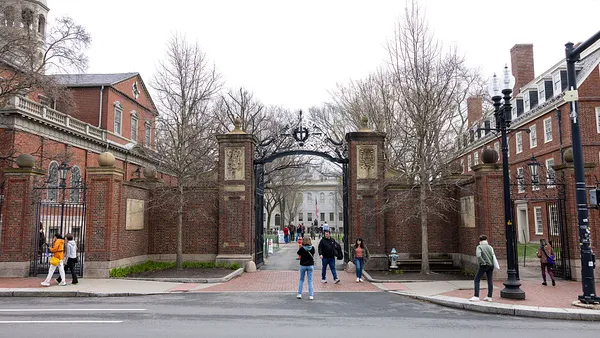Dive Brief:
- Far more higher-income students took out college loans in recent years than did two decades ago, outpacing the uptick in borrowing among lower-income students for the period, according to an analysis from the American Enterprise Institute (AEI).
- The right-wing think tank found nearly 30% of first-year undergraduates from the highest income bracket it studied — whose families earned $114,000 or more annually — borrowed for college in 2015-16.
- That figure is up from 1995-96, when just 16.4% of students from this bracket took out loans. And it raises new questions in the debate over how to address the issue of affordability in higher education, its author notes.
Dive Insight:
Higher ed observers have opined about a crisis in student loan debt and have attempted to pinpoint the reason for the increase in borrowing.
AEI's report highlights that students from higher-income families, which make up a relatively small proportion of higher ed enrollment, borrow disproportionately for college. This may be in part because they tend to enroll in pricier institutions than their lower-income peers.
Meanwhile, about 30% of students from AEI's lowest income bracket — those whose families earn $22,000 or less a year — borrowed for college in 2015-16. This is a nearly identical percentage to the four other income groups studied.
In 1995-96, about 24% of the poorest students were taking out loans. But it's worth noting that while their borrowing rates increased the least from the start to the end of the 20-year period tracked, they would have risen the most had they not dropped off significantly after the 2011-12 academic year.
"In other words, the popular view that low-income students have turned to debt more than other groups was correct up until recently," its author, AEI Resident Fellow Jason Delisle, wrote. He doesn't list a specific reason for the drop-off or whether it will be a lasting trend.
Still, the idea of higher-income students borrowing at higher rates than their lower-income peers adds a new perspective to the current public narrative guiding proposals for free college and universal debt forgiveness.
Colleges, for their part, are adding scholarships and grants to attract middle- and even higher-income students in an attempt to stave off enrollment declines. These students often don't qualify for Pell Grants or many other forms of need-based aid, but they may still struggle to afford college, particularly as costs rise.
Middle-income students' enrollment at selective and flagship institutions has dipped over the last two decades, while higher-income students' share has risen slightly, according to a July 2018 report from AEI.
AEI's latest report, which relies on information from the U.S. Department of Education's National Postsecondary Student Aid Study, shows borrowing rates for students in the other income quintiles jumped between 8 and 11 percentage points during the two decades tracked. For instance, about 21% of students whose families earned between $42,000 and $69,000 a year were taking out loans in 1995-96, compared to 30% in 2015-16.
The report does not track graduate and professional student debt, which accounts for 40% of the national total, according to AEI. It also does not include data on students who didn't complete their degrees.













